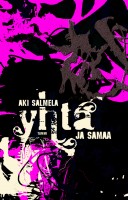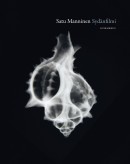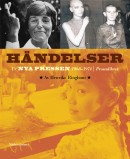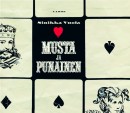Living inside language
23 February 2010 | Essays, Non-fiction
Jyrki Kiiskinen sets out on a journey through seven collections of poetry that appeared in 2009. Exploring history, verbal imagery and the limits of language, these poems speak – ironically or in earnest – about landscapes, love and metamorphoses
The landscape of words is in constant motion, like a runner speeding through a sweep of countryside or an eye scaling the hills of Andalucia.
The proportions of the panorama start to shift so that sharp-edged leaves suddenly form small lakeside scenes; a harbour dissolves into a sheet of white paper or another era entirely. Holes and different layers of events begin to appear in the poems. Within each image, another image is already taking shape; sensory experiences develop into concepts, and the text progresses in a series of metamorphoses.
This kind of landscape is one of the primary tools in the poetry of Olli Sinivaara (born 1980): he allows sensual experiences to flood his text, while imagination simultaneously shapes, conceptualises and moulds the verbal landscape. The reader is moving through a baroque, labyrinthine world of images within images, through a sensory landscape that is constantly being born and reborn. In Sinivaara’s poetry, images are only in the process of coming into existence and reality is not yet complete.
Spindrift is flinging far out over the breakwater.
Glistening-horned oxen of multi-metrical waves
flood the streets of the palace precincts. The sun’s polished gold glitters
and spreads, turquoise’s myriad hoof-tints paw the sand.
The sky’s incredibly bright and gleaming, silver-blue.
The bellowing of those foaming ridges travels far,
sounding down to the depths of the veins,
carrying over the sickening deathly silence of millennia.
When the palace’s last remains have been trampled away,
my rainforest-footed oxen depart and settle down within
the walls of the building-site hut that’ll take the palace’s place.
As a reader, I experienced the illusion of stepping into Sinivaara’s consciousness and walking alongside him through this verbal landscape – almost like watching a film entitled Being Olli Sinivaara. I had no idea that things could be so fascinating inside someone else’s head! It’s a place where things are in constant motion, and that’s why it is best to read Sinivaara’s Valonhetki (‘A moment of light’, Teos) collection slowly; one poem a day is enough.
Exploring borders
 The birth of reality is approached from a rather different perspective in the work of Aki Salmela. Salmela (born 1976) is acutely aware of the ways in which metaphors can lead us astray and how traditional turns of phrase smuggle into our minds the sort of values and presuppositions that should be taken with a pinch of salt. His collection Yhtä ja samaa (‘One and the same’, Tammi) retains this healthy sense of scepticism, but does not settle for mere irony. Salmela has a far more ambitious goal: to maintain a deconstructive hold on the text while, for instance, talking earnestly about love. Like a tightrope walker, the work is delicately balanced between irony and moments of the utmost seriousness. I say this even at the risk of finding that there is in fact no rope beneath the tightrope walker’s feet.
The birth of reality is approached from a rather different perspective in the work of Aki Salmela. Salmela (born 1976) is acutely aware of the ways in which metaphors can lead us astray and how traditional turns of phrase smuggle into our minds the sort of values and presuppositions that should be taken with a pinch of salt. His collection Yhtä ja samaa (‘One and the same’, Tammi) retains this healthy sense of scepticism, but does not settle for mere irony. Salmela has a far more ambitious goal: to maintain a deconstructive hold on the text while, for instance, talking earnestly about love. Like a tightrope walker, the work is delicately balanced between irony and moments of the utmost seriousness. I say this even at the risk of finding that there is in fact no rope beneath the tightrope walker’s feet.
That said, Salmela makes constant use of metaphors – sometimes in jest, sometimes in all seriousness, for homo sapiens has no other means of approaching the unknown. Salmela questions his own metaphors. At the risk of sounding nihilistic, he pulls a new metaphor from his pack of cards and thus the motion continues, because ‘reality doesn’t consist of ideas; it consists of events, which are adept at giving rise to ideas in the minds of those caught up among them’. In Salmela’s prose poems, reality is unfinished and open; it is built from piles of useless junk upon old ruins. The project is condemned to failure, yet the work carries on regardless.
Love, like a hundred little hearts floating snowlike amidst the winter darkness. Love like a snowman in a happy family’s yard. Love like a soft knife against a hard heart. How could a poem go on indefinitely without some love-metaphors, however groundless. How could a way of speaking, how could a style of phrase. How could life, in this phase of life. And let’s assume a cloud shaped like a beautiful face floating in front of a heart-shaped moon, and glowing. And let’s assume. Love, like a carelessly kept promise, like a frail-looking seal fixed to the rest of one’s life, this little postal parcel, being carried by eternity.
Both Aki Salmela and Olli Sinivaara are products of the experimental poetry magazine Tuli & Savu (‘Fire & Smoke’); they both edited the magazine during the early 2000s. As poets, however, their paths have diverged: Salmela is interested in the classical avant garde, the American tradition of ‘language’ poetry and other post-modern trends, while Sinivaara has provocatively come out as a defiant exponent of modernism.
Where Salmela demonstrates the deceitfulness of language – the ways in which language guides and confines our thought processes – Sinivaara writes dazzlingly beautiful poetry, overflowing with images, poetry whose sheer baroque abundance makes any attempt to control it utterly futile. At first glance, it would appear that these two chaps’ aesthetic worlds have nothing in common. However, both of them write texts that exist on the boundary between language and reality – if, indeed, such a boundary is even discernible, given that we all live within the confines of language and cannot escape. It seems, however, that this is precisely what both these poets are trying to do.
Technology sometimes comes between the human body and our sense of reality in such a way that technology itself becomes our reality. Satu Manninen’s second collection of poetry, Sydänfilmi (‘Heartscan’, Gummerus), also exists in a borderland. Manninen (born 1978) has studied at the media art department of the Finnish Academy of Fine Arts, and I believe that the influence of her studies can be seen in her work.
 Manninen examines humans’ relationship with technology; her poems feature all manner of gadgetry – photocopiers, hospital equipment, monitors, screens and electric cables that in a variety of ways connect humans and their senses to machines. Our view of the world becomes fragmentary, as does our view of the body as time and space become increasingly non-linear. Images and sensory experiences collect, one on top of the other, or separate away from one another, and suddenly the human body no longer exists in a unified world.
Manninen examines humans’ relationship with technology; her poems feature all manner of gadgetry – photocopiers, hospital equipment, monitors, screens and electric cables that in a variety of ways connect humans and their senses to machines. Our view of the world becomes fragmentary, as does our view of the body as time and space become increasingly non-linear. Images and sensory experiences collect, one on top of the other, or separate away from one another, and suddenly the human body no longer exists in a unified world.
The body is full of new extremities and probes that shape our experience of our surroundings: ‘On a dark road the mind goes into overdrive, / the link between the left and right lanes is broken. / I drift on to the white area of your ironed shirt, / I open the buttons and read the map of liver spots.’ There is an intimate feel to Satu Manninen’s collection, yet it deals with the kind of all-encompassing change that, unnoticed, affects our very existence with every passing moment.
How would it be to find oneself in a painting of the Fall of Man. I try to cover up the traces, paint a messier and messier dilapidated garden over it, but a garden hose twists in my belly. For so long hope swayed in the wind, and now they’re building a golf course on it, a board game loaded with hotels. The eye of a surveillance-camera eye tracks the bistros being carted along the corridors, hearts beat on the plates.
Pictures of time
In the past few years, the Finnish poetry scene has seen a great deal of so-called ‘search-engine poetry’, which makes use of our collective language hovering in the ethers of the internet. In his debut collection, Hajoamisen syyt (‘Reasons for decomposing’, ntamo), Markku Aalto (born 1970) extracts a portrait of our times from linguistic material he has found on Google; he collides different ways of speaking with one another and lets them reflect ironically upon themselves: this is the linguistic world in which we live today. Aalto works with his material in a skilful yet cynical way.
Just love
It’s always nice to get to know new people, both possible future friends and sex mates. Free love’s on offer, love crossing class and language barriers, hopeless love and so forth. In the latest phase nervous people go weak at the knees when they’re shut up in a dark cell.
Pottering about with the course of one’s life it’s possible to produce an outline of the journey of life; typically the summer of adult life is spent in a whirl of romance. In it mature adults work for a good cause, until the woman’s on the front page of every tabloid, and then, having had a taste of the limelight, she’ll fling off her clothes as well and appear stark naked for the gaping eyes of the public. Thus death and heaven, too, will assume their appropriate places in the chronological continuum.
A mere feeling of love won’t reach further than the bridal bedside. The world falls apart – and changes, actually the very next morning. Folk sit round a candle and reminisce about people, animals etc. that have passed away. They might say aloud, in turn, that ‘I long for you – sign here – and I’d like to say to you… for example, that you’re important to me etc.’ Then they can compose themselves for prayer.
Tabloid past
Forty years ago, everything was still in a state of fermentation: traditional gender roles were breaking down; the world was changing; conservative society was confronted with a belief in progressive values. Henrika Ringbom charts the collective language of the era in her collection of prose poems entitled Händelser (Ur Nya Pressen 1968–1974) (‘Happenings. [From Nya Pressen 1968–1974])’, Söderströms). She has come up with a fascinating working method: in preparation for this collection she has reread old editions of the Swedish-language Nya Pressen, a newspaper that, in her childhood, was an important source of information for her.
A woman in space
Why not send a woman into space? Why not send her on a really long space flight? She would be forced to function. She would have to function as a functioning member of the crew. She would not be taken along as a guest. Already here on earth woman has shown that there are tasks for which she is better suited than a man. She can go from one home to the next, cut up meat, bread fish, fry fillets and freeze the dainty bits. At the wheel of the car she is best naked! The woman and the corset are a lethal combination! Unmarried mothers have more difficult childbirths. Unmarried and mother are a lethal combination! But the housewife has a dream. Her dream begins with the perfect contraceptive pill. And her dream ends. Her dream ends with the perfect water-jug. Why not send her into space? Why not send her on a really long space flight?
Ringbom explores subjects such as the ennui of many a housewife, free sex, the Vietnam War; she follows the moon landings, terrorism, hippies and the growth of affluence just as they were depicted in the pages of Nya Pressen. Ringbom’s method is brilliant: Nya Pressen’s tabloid language takes readers back to the age of innocence that existed forty years ago, but Ringbom’s winks from our contemporary perspective lend the collection an exciting cross-lighting. Rarely have I experienced moments of such clarity as while reading Ringbom’s collection.
Archetypal choices
Jarkko Tontti (born 1979) also delves into the annals of history, though not through a use of historical language but through his protagonist in Jacasser (Otava), a chattering (jacasser, Fr.) oaf (jackass, Eng.) called Jacasser. Is Jacasser the poet’s ironic alter ego, a middle-aged, sceptical, lonely man, who secretly dreams of acts of heroic bravery, though he sees the history that results from them as nothing but a trail of mindlessness? Jacasser is more of an archetype, a kindred spirit of Henri Michaux’s M. Plume, a man who wanders through history at times as the Greek teacher of Emperor Domitian, at other times as a merciless bishop in 17th-century Tartu, his relation to power remaining throughout one of both faithful servant and silent critic.
When Jacasser was old he cast his skin and renewed it like a viper, wrapped himself up as a delicate parchment, a white sheet embroidered with lace. Under his new skin Jacasser was strong and alone. In the evenings he recalled restless African states he didn’t have the courage to visit, houses whose doorbells he’d avoided in fear of an electric shock. Now he’d have time for it all, he’d and he’d. Old and in his skin Jacasser often returned to the water’s edge, sorrowed over the disappearance of the water plants and clear lake water. In the old days it would have been unheard of, the turbidity of an algae lake is the farmer’s gift to future generations. Jacasser also thought about the bottom, the new skin would keep the moisture out, all through that journey.
Tontti tells the story of his trickster protagonist in the third person. With Jacasser’s help, he compares different eras and, in an almost tragicomic light, makes his readers assess the significance of an individual life against the historical backdrop: our relationship to our fathers, to friends, love, to dreams and the seasons. The collection reaches its climax towards the end through a dramatic turn of events; all masks are removed as Jacasser exits the stage. The final poem in the collection is narrated in the first person, as close to the reader as it can possibly be: ‘I remained alone, between people.’ It doesn’t matter whether the speaker is Jacasser, Jarkko Tontti himself, or someone else. What is most important is that he is speaking.
Rules of life
In Stendhal’s classic novel The Red and the Black, the protagonist is caught between two paths: should he follow the Christian path or should he live the life of a soldier? Sinikka Vuola’s poems seem to exist in a limbo between God and our instincts; we are caught between two evils. In her collection Musta ja punainen (‘Black and red’, Tammi), Vuola (born 1972) makes extensive use of archetypes, but takes a further step into the unknown, a mythical wonderland beyond historical time.
Colours have other meanings too, which everyone who has ever gambled will surely know: only red and black can win. In Vuola’s collection, the game is a metaphor for life governed by a strict set of rules. However, those rules are of little use when our destinies are guided by coincidence, leaving us powerless to prevent death, cruelty and violence. The King and Queen of the card game fulfil their archetypal roles; they dutifully uphold the rules of the game, rules that change without our noticing. They step across a chequered stone floor, unable to escape the chessboard.
The troops are iron and steel, their weapons gold and silver
the general, the aide-de-camp, the vehicles, the cannon, the cavalryman, the foot-soldier,
the rook, the king’s bishop and the knight,
The king moves with dignity, a square at a time,
he cannot hurry
and the walking stick is patched up in three places,
The castle, designed and built
In the grandest rooms the floor
with squares too regular
for me to feel good,
He looks at death, death at him with its bottle-green eyes: the enemy
follows my moves but
illness and death don’t,
they move wherever they want Like the Queen
the rest are counters: hardened gold, silver and steel,
So, reality is uncontrollable: ‘the enemy / follows my moves but / illness and death don’t, / they move wherever they want’…. The theme of control is also apparent in the form of these poems. Vuola paces her texts with great precision, creating a finite whole, but lets go of the reins at top speed and allows the lines to flow, so much so that it’s frightening: as if someone suffering from insomnia had stopped obsessively organising their pills and fallen into a deep sleep.
Translated by David Hackston
Poems translated by Herbert Lomas, with the exception of A woman in space, which is translated by David McDuff
No comments for this entry yet


